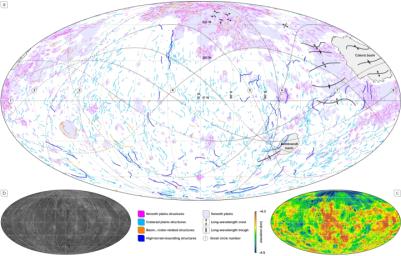
|
The Incredible Shrinking Mercury
- Click the image above for a larger view
- Full-Res JPEG (1100 x 703) (177.1 kB)
- Full-Res TIFF (1100 x 703) (2.3 MB)
Caption:
Scientists have known since Mariner 10 that Mercury has contracted. This contraction is a result of the cooling of Mercury's interior, and is the process responsible for the formation of the planet's wrinkle ridges and lobate scarps . For almost four decades, however, the amount of global contraction measured from spacecraft data has been substantially less than that predicted by models of the thermal evolution of Mercury.
Now, using global photogeological and topographic MESSENGER data of Mercury, members of the MESSENGER team have mapped almost 6,000 ridges and scarps across the planet. Today's image shows the result of this mapping work, with structures color-coded according to one of four classes. (The global photogeological and topographic data used in this study are shown in the bottom left and right, respectively, of the image.) With these results, the MESSENGER team has calculated that Mercury contracted to a much greater extent than had been determined previously from mapping -- by up to seven times more, in fact.
This study was published online in the journal Nature Geoscience on Sunday, March 16, 2014, and is being presented today in the "Mercury" session at the 45th Lunar and Planetary Science Conference , which is being held this week in The Woodlands, Texas. In total, MESSENGER team members are presenting 25 papers at this conference.
Date published online:
March 16, 2014
Center Latitude:
0°
Center Longitude:
0°E
Projection:
Molleweide
Reference:
Byrne
et al.
(2014) Mercury's global contraction much greater than earlier estimates,
Nature Geoscience
,
doi:10.1038/NGEO2097
Background Info:
The MESSENGER spacecraft is the first ever to orbit the planet Mercury, and the spacecraft's seven scientific instruments and radio science investigation are unraveling the history and evolution of the Solar System's innermost planet. MESSENGER acquired over 150,000 images and extensive other data sets. MESSENGER is capable of continuing orbital operations until early 2015.
For information regarding the use of images, see the MESSENGER image use policy .
Cataloging Keywords:
| Name | Value | Additional Values |
|---|---|---|
| Target | Mercury | |
| System | ||
| Target Type | Planet | |
| Mission | MESSENGER | Mariner |
| Instrument Host | MESSENGER | Mariner 10 |
| Host Type | Orbiter | Flyby Spacecraft |
| Instrument | ||
| Detector | ||
| Extra Keywords | Color, Radio, Thermal | |
| Acquisition Date | ||
| Release Date | 2014-03-19 | |
| Date in Caption | 2014-03-16 | |
| Image Credit | NASA/Johns Hopkins University Applied Physics Laboratory/Carnegie Institution of Washington | |
| Source | photojournal.jpl.nasa.gov/catalog/PIA18151 | |
| Identifier | PIA18151 | |
